Understanding the convergence of industry 4.0 and the rise of autonomous vehicles
Contributor Joe Veverka looks at search as an indicator of attitudinal behavior shifts to better understand the rise of the autonomous vehicle (AV) and the mega-disruption of our time: convergence.
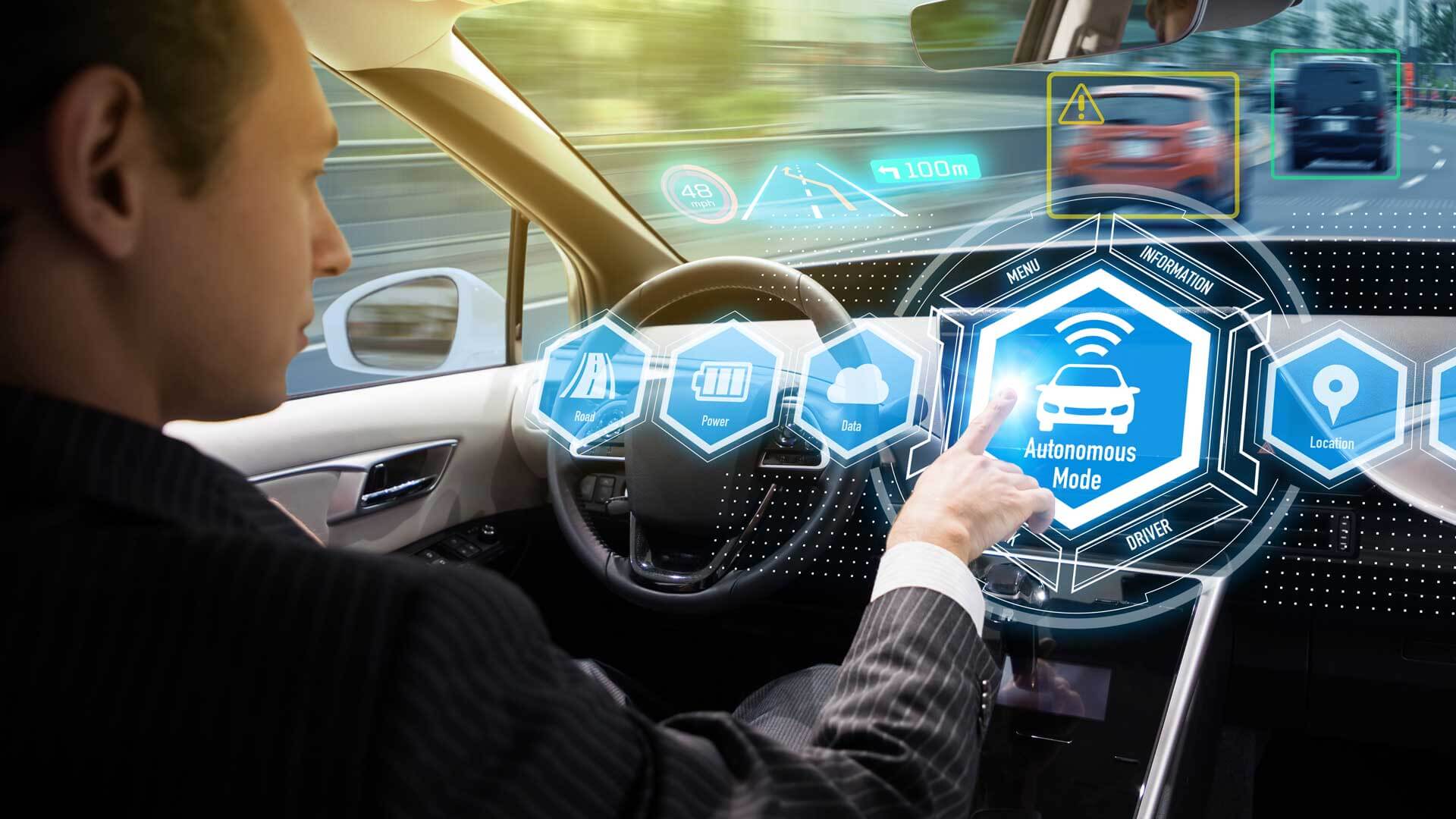
As a society and as marketers, we’ve moved into embracing a brave new world bursting with myriad emerging technologies so quickly that we don’t take the time to understand the interconnections. We see new entrants like cryptocurrency and the internet of things (IoT) as singular, when in fact, they are symbiotic in nature. Together, these trends form an extensive, disruptive infrastructure.
Search advertising is often discussed within the context of a digital marketing vacuum, with the words “performance” and “efficiency” driving conversations. In our busy daily routines, we seldom look past the last click to see what the future may hold.
But search behavior is one of the most accurate predictors of human intent on earth. So, why don’t we look to it more often to answer important questions about what’s happening in our time?
Today, we’ll do just that. Let’s use search in the context of a leading indicator of attitudinal behavior shifts to better understand the rise of the autonomous vehicle (AV) and the mega-disruption of our time: convergence.
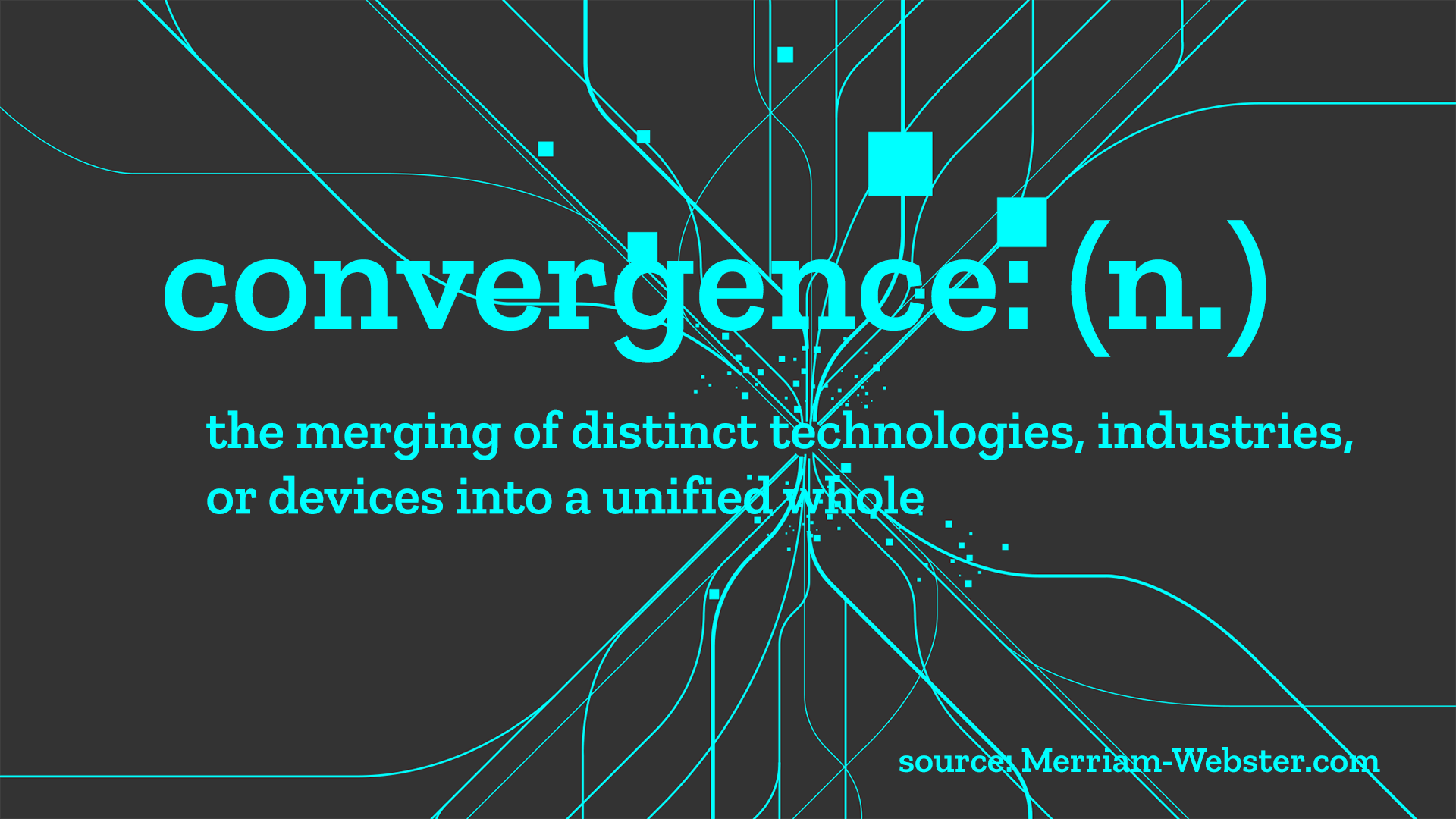
Groundbreaking technologies and the as-a-service economy are deeply interrelated. If you take time to think with precision about the impact of these disruptive trends, you will begin to clearly identify the power of convergence and how these seemingly unique ideas are ubiquitous and closely intertwined. Convergence is the truest form of digital transformation, and it’s happening all around us.
Bing Ads (my employer) recently analyzed 600,000 instances of queries over 16 months from categories aligned with a variety of disruptive trends to better understand and quantify their momentum. What we’ve learned, and our methods, can benefit marketers seeking to reach B2B and B2C audiences in these emerging areas.
In the stream graph below, we looked at six months of recent data and used average site time as a proxy to understand user engagement:
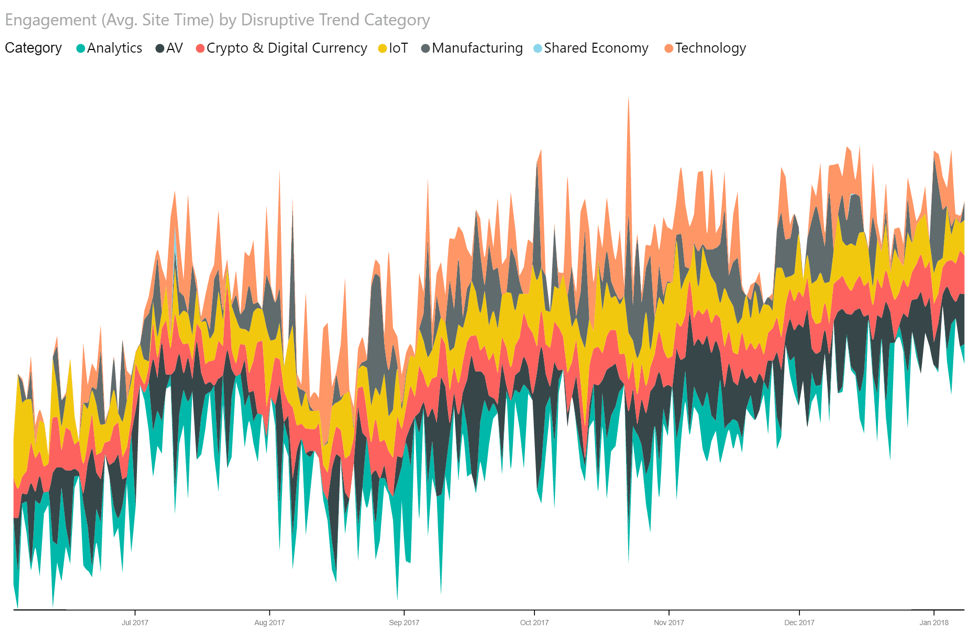
Queries analyzed range from “FinTech” and “digital twin technology” to “predictive analytics.” You’ll notice the colored bands rising to the right across the y-axis over time. The thickness of each band provides insight into the frequency of activity.
While some bands sustain their thickness, others get thicker or dissipate. Our visualization specifically denotes increased interest in technology, manufacturing and autonomous vehicles as these trends continue their journey to convergence and eventual mainstream adoption.
Convergence is most profound when discussing the seismic revolution of Industry 4.0. Now, it might seem odd that a search marketer like me has taken an interest in a disruptive trend deeply entrenched in manufacturing. What gives?
While the base of Industry 4.0 is manufacturing, McKinsey defines the core DNA of this convergent disruption as the proliferation of big data, advanced analytics, human-machine interfaces and digital-to-physical transfers providing profound opportunities for new business models and delivery systems.
This will unequivocally change search; it’s just a matter of time until we understand to what depth. Auto, Retail, Finance, Technology and Telecommunications will all be profoundly entrenched in Industry 4.0, and the digitalization of these verticals will demonstrate the significant impact of convergence, which we will likely witness in real time.
Predicting how marketing will occur in the self-driving car area
For instance, take Automotive and the pending impact of autonomous vehicles. Often referred to as MaaS or TaaS (Mobility/Transportation as a Service), this disruption could shift the entire auto industry into an accelerated state of convergence. In redefining an as-a-service automotive industry, the delivery model of shared economy at scale will require a colossal amount of connectivity data to derive insights from consumer behavior to properly optimize delivery systems.
So, how will search play a role in this new era? Given all of the interest from both businesses and consumers, how will marketers targeting businesses that are part of the manufacturing value chain find their audiences? Will audience-oriented data need to be employed? Let’s look at the data. For our next analysis, we classified queries as either B2B or B2C, adding long-tail queries that signal intent to our original scope:
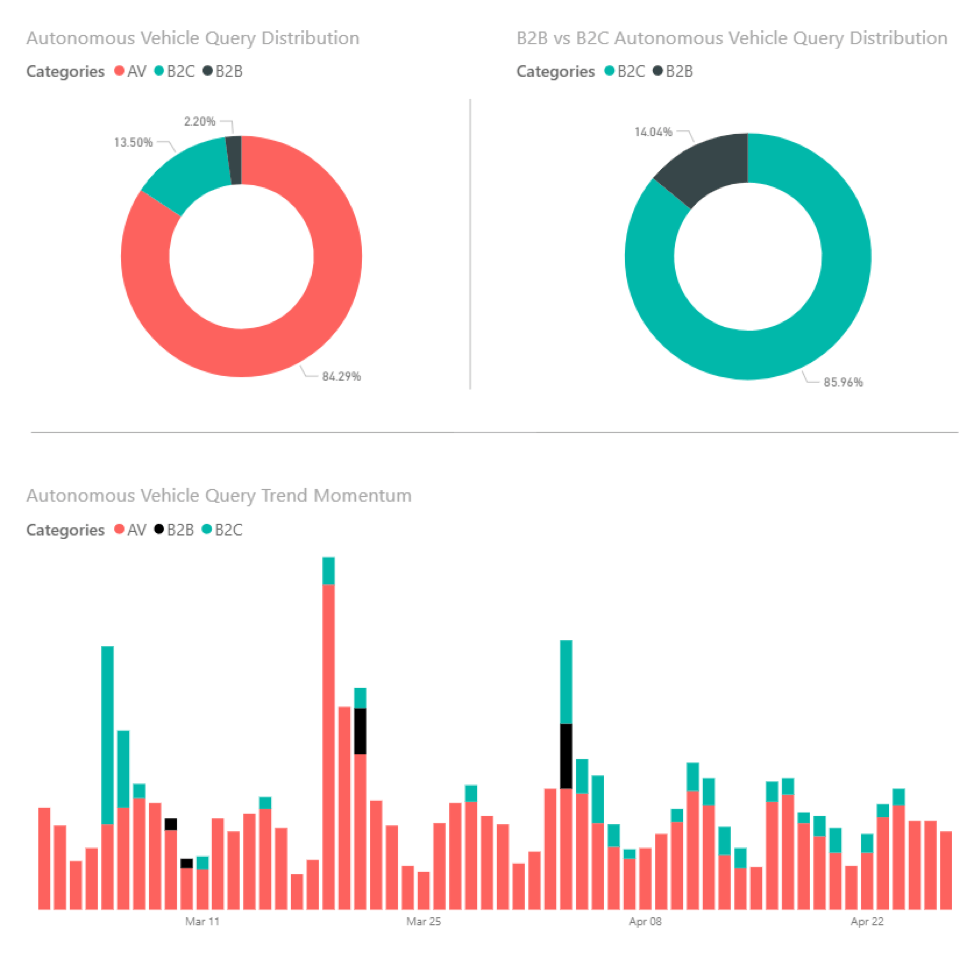
Illustration of query categorizations >> B2B: [self-driving car technology leaders], B2C: [when will autonomous cars be available], AV: [autonomous vehicles]. Sample representative of a subset of queries from larger population; results should be regarded as preliminary.
Our findings showcase that while the most significant query volume sits in universal autonomous vehicles queries (84 percent), there is clear B2B and B2C intent-driven representation. We see signals that consumer sentiment has begun to gain momentum. B2C represents upwards of 13 percent of overall query volume for autonomous vehicles. When we remove generic (non-intent-driven) AV queries, we find 86 percent of autonomous vehicle queries are B2C-centric (vs. B2B).
We previously mentioned that a key aspect of Industry 4.0 is predictive analytics. Now that we’ve shared some baseline data, let’s drive a bit more precision to our projections with Moving Average Convergence Divergence (MACD). MACD is defined by Investopedia as a trend-following momentum indicator that shows the relationship between two moving averages.
Specifically, it provides insight into changes in magnitude, direction, acceleration and interval of a trend. If we analyze our autonomous vehicle query data leveraging the MACD technique, we can understand the profound potential impact of this convergent disruption:
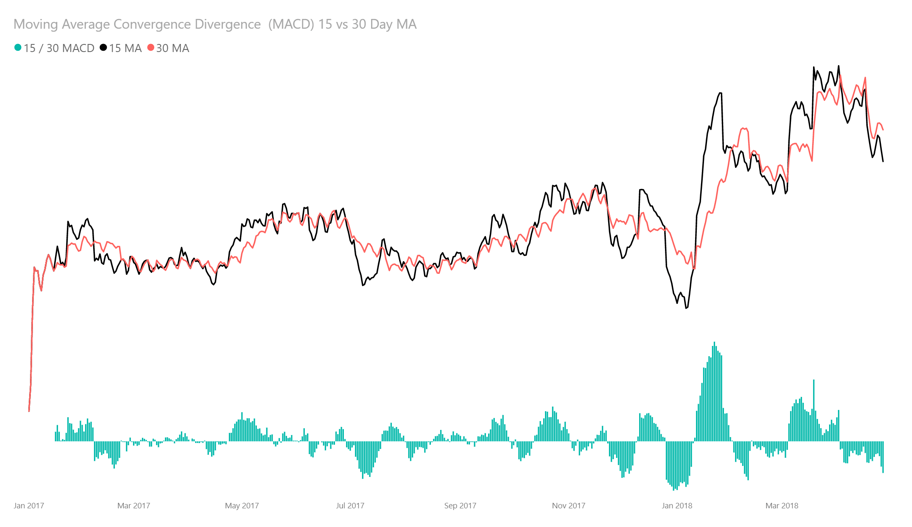
By dissecting these moving averages, we can clearly see as-a-service autonomous vehicle queries gaining momentum and can predict that incremental waves of interest are forthcoming.
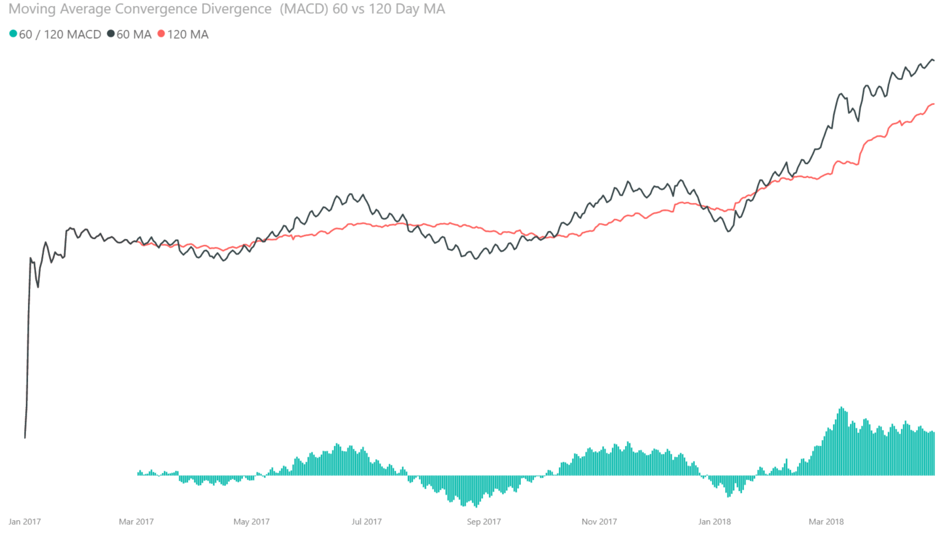
Case in point: If we contrast the 15- vs. 30-day moving average MACD with a 60- vs. 120-day moving average view, you’ll notice the sustainability of the trend.
Utilizing MACD, it becomes apparent that convergent trends (like autonomous vehicles) are more than ideas, more than disruptions; they have very squarely “arrived,” and it’s imperative to understand not only the impact across search, but also how it may shift the advertising landscape. For example, since many of these searches lack intent, separating the merely curious from the intent-driven could possibly be accomplished by layering audience-centric solutions on top of the query data.
Where do we go from here? Over the next several months, we will continue monitoring the impact of Autonomous Vehicles, IoT, FinTech and other convergent disruptions to see how things develop. A similar approach would benefit any marketers seeking to serve businesses or consumers involved in these emerging areas.
Convergence is a one-way ticket to understanding the next chapter in human behavior, so strap in and get ready. It’s going to be a wild ride, but this time, the robots will be driving.
Contributing authors are invited to create content for MarTech and are chosen for their expertise and contribution to the martech community. Our contributors work under the oversight of the editorial staff and contributions are checked for quality and relevance to our readers. MarTech is owned by Semrush. Contributor was not asked to make any direct or indirect mentions of Semrush. The opinions they express are their own.
Related stories